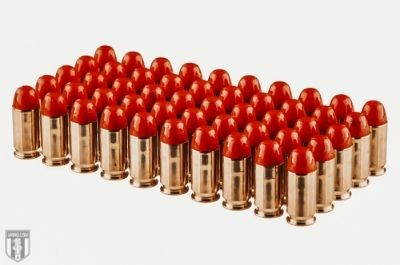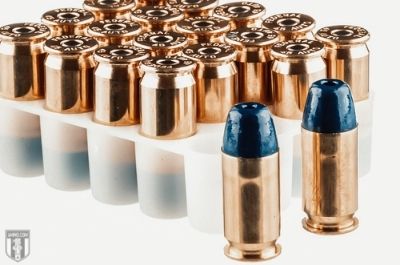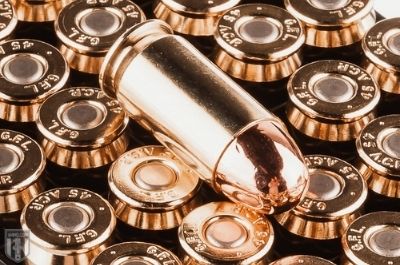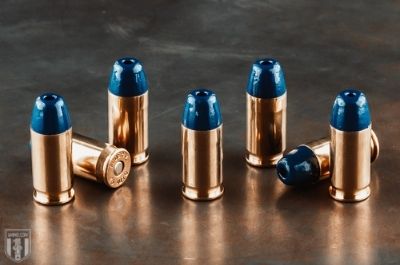45 vs 38 Super: Which Is Best For Your New 1911?
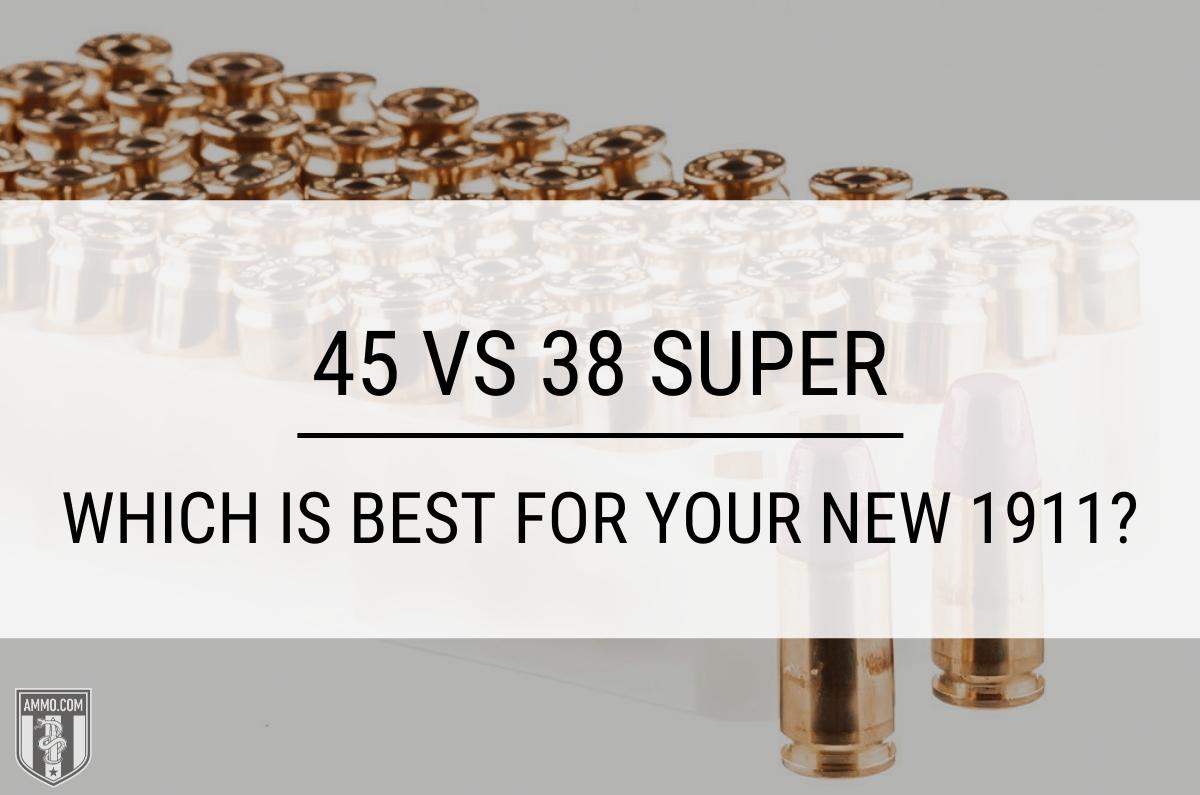 The 38 Super and 45 ACP are two powerful centerfire handgun cartridges most commonly chambered in the 1911 pistol.
The 38 Super and 45 ACP are two powerful centerfire handgun cartridges most commonly chambered in the 1911 pistol.
Although a somewhat obscure cartridge, the 38 Super is held in high regard in the competitive shooting community and was originally developed for law enforcement to defeat the rudimentary body armor and light sheet steel car doors of the 1930’s.
The prowess of the 45 ACP is well established and has been battle proven for well over a century in war and on the streets.
When considering a new handgun caliber, it’s a good idea to understand the advantages and disadvantages of each before making a final decision.
In this article we will take an in depth look at the 45 ACP and 38 Super to help you decide which of these handgun cartridges will be the best option for your new semi-automatic pistol.
What is The Difference Between 45 and 38 Super?
The difference between 45 and 38 Super is the bullet diameter each cartridge fires and their muzzle velocity. The 45 ACP fires a 0.452” diameter bullet at lower muzzle velocity while the 38 Super fires a 0.356” diameter bullet at higher muzzle velocities.
Cartridge Specs
When comparing two handgun cartridges, it’s a good practice to examine the differences in case design to gain more knowledge of each.
Obviously, the biggest difference between the .38 Super and .45 ACP is the bullet diameter that each cartridge fires. The 45 ACP fires a 0.452” diameter bullet compared to 0.356” for 38 Super. For reference, a bullet diameter of 0.356” is the same as those fired in the 9mm Luger.
Another major difference is that the 38 Super cartridge is semi-rimmed while the 45 ACP is a rimless design. The semi-rim can cause feeding problems in double stack magazines in a condition referred to as rimlock. As the 38 Super is very popular for open gun shooters in IPSC and USPSA that need to make major power factor, there are variants of the 38 Super that are nearly rimless to remedy the any feeding issues.
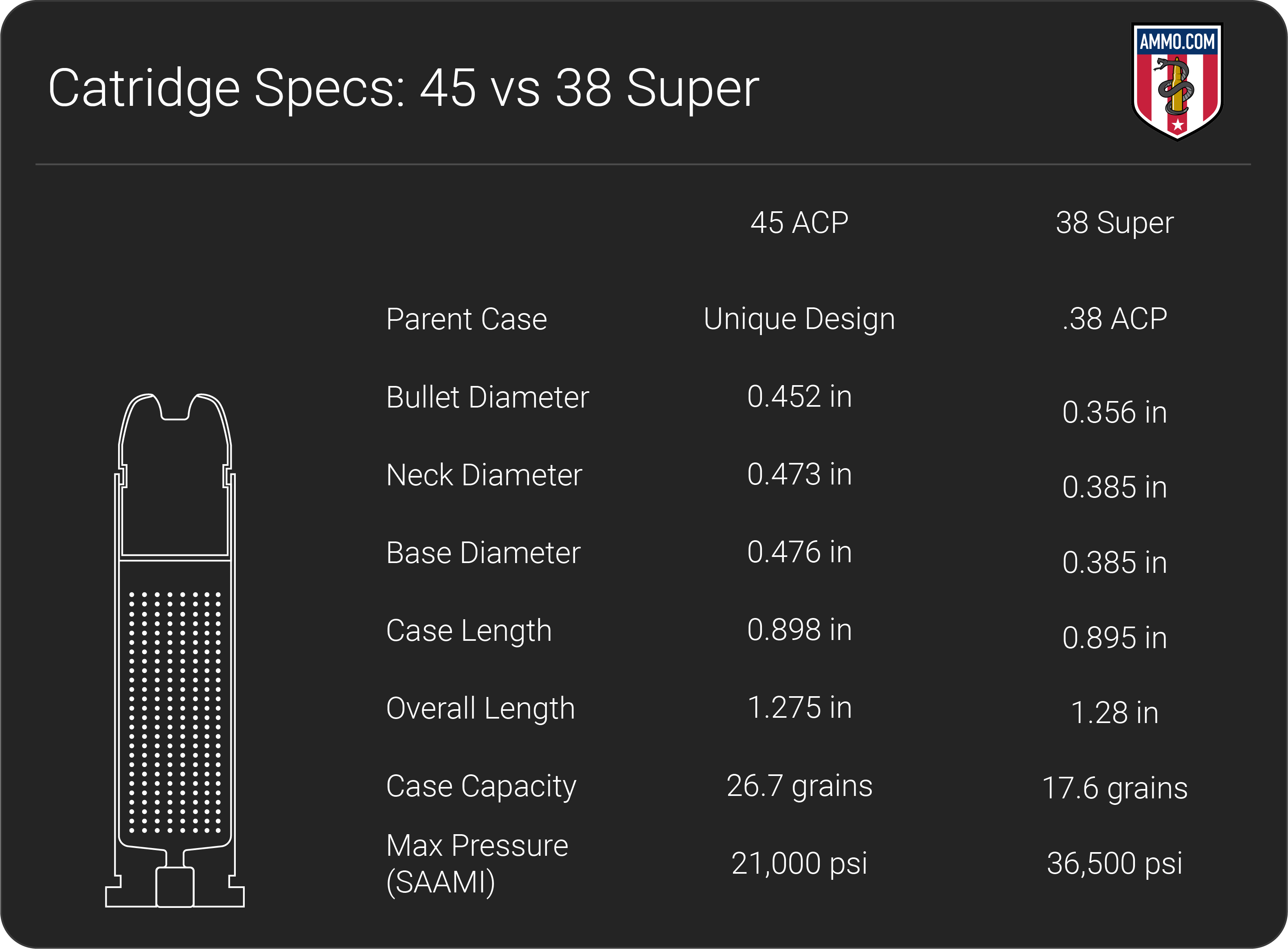
The other major difference between the 45 and 38 Super is the maximum pressure each handgun cartridge can handle. The 45 ACP is a lower pressure round and can handle 21,000 psi of pressure per SAAMI specs. In contrast, the 38 Super is rater for higher pressure and can handle 36,500 psi, which is 14,500 psi higher than 45 and 1,500 psi higher than 9mm Luger.
As the 38 Super has a smaller diameter than the 45, it’s no surprise that the 38 Super has a lower case capacity than its big brother, the 45 ACP. The 38 Super can house 17.6 gr of powder while the 45 has over 50% more case capacity at 26.7 gr.
The case length and overall length between both handgun cartridges is essentially identical. This is because the 38 Super was designed to be fired from the Colt 1911 handgun, therefore the 38 Super had to conform to the magazine overall length requirements for the pistol. Both cartridges headspace off the case mouth as opposed to a 357 Magnum which will headspace off the rim.
Stopping Power/Kinetic Energy
Stopping power is one of those ubiquitous terms that gets thrown around campfires and gun store counters and is completely unquantifiable. You’ll hear stories of how boutique rounds like the 357 SIG have “More stopping power than a 9mm Luger” or how, “The 357 Magnum is a real man stopper”.
The important thing to remember is that shot placement is more important than any ballistics values as a .22LR between the eyes will always be more lethal than a 500 Smith & Wesson Magnum to the hand.
However, we can quantify how many ft-lbs of force is imparted upon the target for each cartridge.
Muzzle energy is directly correlated to bullet weight and muzzle velocity, therefore different factory loads will have energy based on how hot they want to make the cartridge.
Your run of the mill 130 grain full metal jacket (FMJ) 38 Super practice ammo will typically have a muzzle velocity around 1,200 fps and 425 ft-lbs of energy. Comparatively, Winchester white box 230 grain FMJ 45 ACP ammo will run around 835 fps and 356 ft-lbs at the muzzle.
Clearly the 38 Super has more ft-lbs of muzzle energy compared to the 45 ACP, however these are just practice loads. Self-defense jacketed hollow point (JHP) ammo from manufacturers like Buffalo Bore, Cor-Bon, or Underwood is typically loaded hotter for deeper penetration.
Both the 45 ACP and 38 Super have +P loads available and registered with SAAMI. +P loads are those that are loaded to higher pressure for improved terminal ballistic performance. However, that added pressure comes at the cost of higher recoil and muzzle flip, so make sure to practice with your defense loads in your concealed carry gun, as they can be more difficult to shoot than FMJ practice ammo.
For example, Buffalo Bore offers a 38 Super +P 115 grain hollow point that leaves the muzzle at 1,450 fps with 537 ft-lbs of energy (20% higher than practice ammo). Furthermore, a 185 grain hollow point +p 45 ACP load can leave the muzzle at 1,200 fps and 592 ft-lbs of energy (which is higher than 38 Super).
Safety Note: Not all handguns chambered in 45 ACP or 38 Super are rated for +P ammo. Refer to your owner’s manual or manufacturer’s website to determine if your handgun can handle +P loads. If you are still unsure, then seek the services of a qualified gunsmith.
Both the 38 Super and 45 ACP are powerful handgun cartridges and will have more than enough kinetic energy to stop a threat should you find yourself in a self-defense situation. Although muzzle energy will be dependent upon the manufacture of your defense loads, both will have more than enough stopping power for your concealed carry semi-auto handgun.
Recoil
Recoil is an important consideration when purchasing a new self-defense handgun. A round with heavy recoil will be more difficult to control and will slow your rate of follow up shots.
Recoil is affected primarily by muzzle velocity (FPS) and bullet weight. The faster a bullet travels, the harder it pushes back on the shooter. Furthermore, a heavier bullet requires more force to push it out the barrel, which is returned to the shooter’s wrists.
The way recoil is felt varies from shooter to shooter.
In general, the 38 Super will have less recoil than the 45 ACP. As it shoots lighter bullets, the 38 Super will have less momentum and therefore less force transferred back into the shooter’s wrists.
However, neither cartridge is known for having offensive or painful recoil. Although the 45 ACP will have more free recoil energy, many shooters report it as feeling like a rolling push that is very manageable with minimal muzzle flip.
The bottom line is that you should not have a problem shooting all day at the range with your favorite semi-auto handgun for either cartridge. However, for recoil sensitive shooters, the 38 Super is the better choice.
Velocity/Penetration
If there’s one thing that the 38 Super is known for, it’s velocity and penetration.
During the Prohibition Era of the late 1920’s and early 1930’s, bootleggers and gangsters started using early forms of body armor. Essentially just a thin layer of steel, the new body armor was strong enough to stop the 45 ACP loads law enforcement carried at that time, but it could not handle the 38 Super.
When it comes to defeating body armor and car doors, speed kills. And 38 Super was very fast for the era and easily punched through these barriers that law enforcement needed to defeat.
Although the 38 Super cannot defeat modern body armor, it is still the better option for shooters who want a flatter trajectory, higher muzzle velocity, and deeper penetration.
Magazine Capacity
The 38 Super will generally have more rounds in the magazine than a 45 ACP.
As the 38 Super is the smaller cartridge, it’s easier to fit more rounds in the magazine. Single stack magazines for the 1911 will typically hold 9-10 rounds for 38 Super and 7-8 rounds for 45 ACP.
For double stack mags for 38 Super can easily accommodate 17 rounds or more for IPSC/USPSA race guns (24+ rounds). Double stack 45 ACP magazines typically carry around 12-13 rounds.
Hunting
Neither the 38 Super nor 45 ACP is known for being a good option as a hunting round. Most semi-auto handgun cartridges lack the required kinetic energy (1,000 ft-lbs) needed to ethically harvest whitetail and both the 38 and 45 are in this category. For medium sized game, a 44 or 357 Magnum would be a better option.
For small game or varmints, either cartridge would work if you could get close enough. The 38 Super would be the better option as it has a flatter trajectory and will be easier to use at long range than the 45 ACP. However, as most varmints and small game are excellent at keeping their distance from humans, neither round is a particularly good option for hunting.
Concealed Carry/Home Defense
What the 38 Super and 45 ACP lack in hunting prowess, they more than make up for in self-defense capability.
Ever since the introduction of the Colt 1911, 45 ACP pistols have been extremely popular for home defense and concealed carry. Shooters and CCW permit holders love the raw power the 45 ACP provides as well as the massive permanent wound channel that modern hollow point ammo offers.
The 38 Super never really got its time to shine and lived in relative obscurity as the 9mm Luger took center stage as the premier 9mm diameter bullet.
However, the 38 Super is an extremely capable self-defense round and should not be overlooked especially if you enjoy the 1911 platform.
Although there are fewer handguns available in 38 Super, a 1911 in 38 Super offers many advantages for concealed carry over its 45 ACP counterpart. The 38 Super has higher magazine capacity and less recoil than a 45 ACP even in a commander sized 1911. This makes for a potent carry package that will allow shooters to carry more rounds for the same weight as a 45 ACP. And when you are concealed carrying, more rounds are always better.
However, ammo weight is not a consideration for home defense, and this is where the 45 ACP really shines. As the 45 ACP has generally lower penetration, this means it will have a lower propensity to over penetrate. Over penetration is an important consideration when taking shots inside the home, whether you live in an apartment or subdivision, as the last thing you want is for your rounds to injure an innocent bystander.
While the added penetration is a benefit for concealed carry, as shots may need to punch through multiple layers of clothing, it is more of a liability for home defense.
Therefore, the 45 ACP is the better choice for home defense while the 38 Super is a great option for concealed carry.
Ammo and Handgun Cost/Availability
Ammo cost is something to think about when considering new semi-automatic pistols, as you want to make sure that you can afford to practice with your new handgun.
Although neither round is ridiculously expensive, the 45 ACP will generally cost less to shoot as it is more popular than the 38 Super.
Buying in bulk is always smart, make sure to check out our stock of bulk 45 ACP ammo.
In general, FMJ practice ammo will run you about $0.60/round and premium JHP defense loads will cost about $1/round (or more) for 45 ACP. For 38 Super, FMJ ammo typically runs about $0.90/round and JHP ammo costs on average $1.50/round.
The lack of popularity really hurts your 38 Super ammo options as there are fewer manufacturers who have offerings for the handgun cartridge. Reloading helps with this, and that will be discussed in the next section.
For handguns, most 38 Super offerings are 1911’s or compensated 2011 patterned handguns reserved for competition. Therefore, if you don’t like the 1911 platform, you are extremely limited with the 38 Super.
In contrast, there are a myriad of semi-automatic pistols available in 45 ACP as it is one of the most popular handgun cartridges in the USA. Of course, the venerable 1911 is extremely popular, but Smith & Wesson, Remington, Glock, Springfield, Ruger, Sig Sauer, and CZ all have 45 ACP pistols that are NOT 1911s.
When it comes to overall cost and availability, the 45 ACP is clearly superior to the 38 Super due to sheer volume and popularity.
Reloading
Reloading is one method that many shooters use to reduce their overall cost per round. As 38 Super factory loads are harder to come by, shooting handloaded ammo is one method that many fans of the caliber use to ensure that their ammo supplies are always flush.
The 38 Super cartridge offers a lot of flexibility in terms of reloading, as you can load it hot for higher muzzle velocity or use less powder for a softer-shooting practice round.
Many competitive shooters appreciate the 38 Super and its ability to be loaded hotter than the 9mm for their open guns with a compensator. These shooters need to make major power factor, a rating used in USPSA and IPSC, based on bullet weight and muzzle velocity to put themselves in a more favorable scoring system.
The problem with 9mm Luger is that you must load the cases well over book maximum to reach major power factor. With 38 Super, you do not need to load the rounds as hot since the case is rated for higher pressure.
Before shooting handloaded ammo or anything near maximum pressure out of your handgun, you should always consult a gunsmith to ensure your chamber is rated to handle higher pressure. Never load over manufacturer’s published maximum charges for your given cartridge.
Ballistics: 45 vs 38 Super
Our team here at Ammo.com has spent countless hours scouring the Internet to bring you extremely comprehensive ballistics tables for both calibers. These tables will compare bullet weight to muzzle velocity, kinetic energy, and trajectory.
38 Super Ballistics: Chart of Average 38 Super Ballistics
Note: This information comes from the manufacturer and is for informational purposes only. The actual ballistics obtained with your firearm can vary considerably from the advertised ballistics. Also, ballistics can vary from lot to lot with the same brand and type load.
| 38 Super Bullet WEIGHT | Muzzle VELOCITY (fps) | Muzzle ENERGY (ft. lbs.) | Mid-Range TRAJECTORY (in.) | Barrel Length (in.) | |||||
|---|---|---|---|---|---|---|---|---|---|
| Muzzle | 50 yds. | 100 yds. | Muzzle | 50 yds. | 100 yds. | 50 yds. | 100 yds. | ||
| 115 Grain +P | 1130 | 1016 | 938 | 326 | 264 | 225 | 1 | -9.5 | n/a |
| 115 Grain +P | 1300 | 1145 | 1040 | 430 | 335 | 275 | 0.7 | 3.3 | 5" |
| 125 Grain +P | 1215 | 1100 | 1015 | 425 | 350 | 300 | 0.8 | 3.6 | 5" |
| 130 Grain +P | 1215 | 1100 | 1015 | 425 | 350 | 300 | 0.8 | 3.6 | 5" |
| 147 Grain +P | 1100 | 1050 | 1000 | 395 | 355 | 325 | 0.9 | 4 | 5" |
45 ACP Ballistics
Note: This information comes from the manufacturer and is for informational purposes only. The actual ballistics obtained with your firearm can vary considerably from the advertised ballistics. Also, ballistics can vary from lot to lot with the same brand and type load.
| 45 Auto (ACP) Bullet WEIGHT | Muzzle VELOCITY (fps) | Muzzle ENERGY (ft. lbs.) | Mid-Range TRAJECTORY (in.) | Barrel Length (in.) | |||||
|---|---|---|---|---|---|---|---|---|---|
| Muzzle | 50 yds. | 100 yds. | Muzzle | 50 yds. | 100 yds. | 50 yds. | 100 yds. | ||
| 150 Grain | 1050 | n/a | n/a | 403 | n/a | n/a | n/a | n/a | n/a |
| 165 Grain | 1030 | 930 | n/a | 385 | 315 | n/a | 1.2 | n/a | 5" |
| 165 Grain Guard Dog | 1140 | 1030 | 950 | 475 | 390 | 335 | n/a | n/a | 5" |
| 185 Grain | 1000 | 940 | 890 | 410 | 360 | 325 | 1.1 | 4.9 | 5" |
| 185 Grain Match | 770 | 705 | 650 | 245 | 204 | 175 | 2 | 8.7 | 5" |
| 200 Grain | 940 | 890 | 840 | 392 | 352 | 312 | 2 | 8.6 | 5" |
| 200 Grain | 975 | 917 | 860 | 421 | 372 | 328 | 1.4 | 5 | 5" |
| 230 Grain | 830 | 800 | 675 | 355 | 325 | 300 | 1.6 | 6.8 | 5" |
| 230 Grain | 880 | 846 | 816 | 396 | 366 | 340 | 1.5 | 6.1 | 5" |
| 165 Grain +P | 1250 | n/a | n/a | 573 | n/a | n/a | n/a | n/a | n/a |
| 185 Grain +P | 1140 | 1040 | 970 | 535 | 445 | 385 | 0.9 | 4 | 5" |
| 200 Grain +P | 1055 | 982 | 925 | 494 | 428 | 380 | n/a | n/a | 5" |
38 Super Development/History
The 38 Super was developed and released by the Colt Manufacturing Company in 1929 and was initially marketed to law enforcement to penetrate early forms of body armor and car doors.
Developed from the .38 ACP (NOT the same as the 380 ACP), the 38 Super was capable of handling higher pressures and allowed the round to achieve the muzzle velocity needed to penetrate the obstacles law enforcement faced.
Also known as the 9x23mmSR, 38 Superauto, or 38 Super Auto, the 38 Super retains the same external case dimensions as its parent case. However, the 38 ACP was designed to headspace off the semi-rim of the case and once the 38 Super was adapted to the 1911 platform, the case rim was no longer supported. This caused the 38 Auto to be inherently inaccurate as the case was not supported in the chamber.
It wasn’t until Irv Stone of Bar-Sto barrels re-designed the 38 Super chamber to headspace off the case mouth that the accuracy of the 38 Super was realized.
Although the 38 Super was the answer that law enforcement needed at the time, it was quickly eclipsed by the release of the 357 Magnum a mere 6 years later.
The 38 Super was designed to fire a 130 grain bullet at 1,215 fps and have 426 ft-lbs of muzzle energy.
Today, the 38 Super is held in high regard in competitive shooting circles, as it allows Open Class shooters to achieve major power factor in their compensated race guns without loading their cases to dangerous pressure levels.
45 ACP Development/History
The 45 ACP (Automatic Colt Pistol) was developed by the renowned American firearms inventor, John Moses Browning, in 1904. The 45 ACP was an innovation, as many are, birthed from necessity.
During the Philippine-American War, the US Cavalry became displeased with the lack of stopping power provided by their .38 Long Colt sidearms. The US military concluded that bigger bullets with more stopping power were required, and that the ideal caliber for this duty was .45 due, in part, to the success of the 45 Long Colt.
Prior to this development, John Moses Browning had been working in tandem with Colt to develop a new 41 caliber for consideration. However, when this new order came from the US Military, Colt and Browning increased the caliber to .45.
Initially the new 45 ACP cartridge was designed to fire a 200-grain bullet at 900 fps. However, after some modifications by the Frankford Arsenal, Union Metallic Cartridge, and Winchester, the finalized version was adorned with a 230-grain full metal jacket (FMJ) fired at 850 fps.
The final version of the 45 ACP mimicked the ballistic performance of the 45 Schofield and the 45 Long Colt but was significantly shorter.
In 1906, Colt (using Browning’s design) and 5 other firearms manufacturers submitted handguns for consideration. Only Colt and Savage Arms made the final cut in 1910. The resulting testing run by the US Military showed the Colt submission experiencing zero failures while the Savage sidearm had 37 stoppages. The Colt handgun was selected as the Model 1911.
The Colt 1911 and the 45 ACP served in all branches of the US Military for the next 70+ years as the standard issue sidearm and ammo. It carried us through World War I and II, the Korean War, and Vietnam. It was not until the 1980s that the military decided to update their service pistol and opted to move towards the Beretta M9 and the 9mm Luger cartridge.
The 45 ACP is well known in the shooting community for its stopping power, accuracy, and reliability.
In general, the 45 ACP is a low-pressure round with SAAMI specs citing a maximum pressure of 21,000 psi (considerably less than 35,000 psi for 9mm). It is naturally subsonic, which makes it ideal for use with a suppressor/silencer or submachineguns.
Your standard, off-the-shelf 230 grain full metal jacket (FMJ) Winchester ammo will have a muzzle velocity of 835 fps and muzzle energy of 356 foot-pounds of force.
The 45 ACP is truly America’s Cartridge and it has a huge following both in military, law enforcement, and civilian shooting circles across the USA.
If you’d like to learn more about how the 45 ACP compares to other calibers, check out these articles below:
Final Shots: 38 Super vs 45
Some shooters will dismiss the 38 Super as a handgun cartridge only for competition without any practical use for concealed carry or self-defense when this couldn’t be further from the truth. The 38 Super offers exceptional terminal ballistics, penetration, and muzzle energy that rival the 45 ACP all with less recoil and lower muzzle flip than a 40 S&W.
The 45 ACP is truly America’s Cartridge and is battle-proven through two World Wars and beyond. Next to the 9mm Luger, it is one of the top handgun cartridges in the USA and its popularity will undoubtedly remain extremely high for decades to come.
The benefits of both cartridges are aptly displayed in the 1911 platform that is beloved by many shooters in North America and across the world.
The only downside to the 38 Super is its lack of ammo and handgun options. As popularity for the cartridge never really took off, it limits a shooter’s ability to reliably source ammo unless they take up reloading.
If you’re looking for a handgun cartridge that you can pick up at every gun shop or sporting good store across the nation, then go with the 45 ACP.
However, if you like to shoot something different that perfectly marries the stopping power of the 45 ACP, magazine capacity of the 9mm, and you enjoy handloading, then the 38 Super is for you.
Regardless of which cartridge you choose, make sure you are fully stocked up on bulk ammo here at Ammo.com and get out to the range and perfect those marksmanship skills!
Ammo Comparisons
- .308 vs 5.56
- 6.5 Creedmoor vs .308
- .300 Blackout vs .308
- .300 Win Mag vs .308
- .243 vs .308
- .308 vs .30-06
- 7mm-08 vs .308
- .270 vs .308
- 7.62x39 vs .308
- .223 vs .308
- .338 Lapua vs .308
- .380 ACP vs 9mm
- .223 vs 5.56
- .300 Blackout vs 5.56
- 9mm vs 45 ACP
- 9mm vs 40 S&W
- .357 SIG vs 9mm
- 10mm vs 9mm
- 9mm vs 9mm Luger
- .243 vs .270
- .300 Win Mag vs .30-06
- .270 vs .30-06
- .40 vs .45
- 38 Special vs 357
- 9mm vs 40 vs 45
- 5.56 vs 7.62x39
- 338 Lapua vs .30-06
- .30-30 vs .30-06
- 300 PRC vs 338 Lapua
- .30-06 vs 7mm
- 300 Win Mag vs 338 Lapua
- 300 PRC vs 300 Win Mag
- 300 WSM vs 300 Win Mag
- 338 Win Mag vs 338 Lapua
- 12 Gauge vs 20 Gauge
- 10mm vs 357 Mag
- .30-30 vs 7.62x39
- 224 Valkyrie vs 22-250
- 17 HMR vs 22 Mag
- 7.62x39 vs .300 Blackout
- 45 ACP vs 45 Auto
- 45-70 vs 30-30
- 300 Blackout vs 223
- 357 Magnum vs 9mm
- 350 Legend vs 300 Blackout
- 224 Valkyrie vs 223
- 45 ACP vs 38 Super
- 6.5 Grendel vs .308
- 17 HMR vs 22 LR
- 10 Gauge vs 12 Gauge
- 22-250 vs 223
- 45 Colt vs 45 ACP
- 350 Legend vs 30-30
- 5.7x28 vs 223
- 5.7 vs 9mm
- 5.56 vs 5.7
- 22 vs 9mm
- Buckshot vs Birdshot
- 450 Bushmaster vs 308
- 450 Bushmaster vs 223
- Buckshot vs Slug
- 6.5 Grendel vs 5.56 vs 223
- 6mm ARC vs 6.5 Grendel
- 44 vs 45
- 458 SOCOM vs 5.56
- 357 vs 44
- 32 ACP vs 380
- 300 Win Mag vs 338 Win Mag vs 338 Lapua Mag
- 450 Bushmaster vs 458 SOCOM vs 50 Beowulf
- 6mm Creedmoor vs 6.5 Creedmoor
- TMJ vs FMJ
- 44 Special Vs 44 Magnum
- 45 90 vs 45 70
- 6.8 Western vs 6.8 SPC
- 50 Beowulf vs 50 BMG
- 26 Nosler vs 6.5 PRC
- 28 Gauge vs 410
- 6.8 SPC vs 5.56
- 6.8 SPC vs 6.5 Grendel
- 6.8 Western vs 7mm Rem Mag vs .28 Nosler
- 6.8 Western vs 6.5 Creedmoor
- 22 Hornet vs 223
- 6.8 Western vs 6.5 PRC
- .410 vs 12 Gauge
- .410 vs 20 Gauge
- 22 LR vs 22 Mag
- 6mm ARC vs 243
- 7mm-08 vs 270
- 243 vs 6.5 Creedmoor
- Nickel vs Brass Casing
- 204 Ruger vs 223
- 50 Beowulf vs 5.56
- 260 Remington vs 6.5 Creedmoor
- 6mm Remington vs 243
- 28 Nosler vs 300 PRC
- 50 Beowulf vs 50 AE
- 22 Nosler vs 22-250
- 450 Marlin vs 45-70
- 300 Win Mag vs 300 Norma
- 458 SOCOM vs 300 Blackout
- 38-55 vs 45-70
- 22 Hornet vs 22 LR
- 300 Norma vs 338 Lapua
- 338 Lapua vs 50 BMG
- 28 Nosler vs 300 Win Mag
- 28 Nosler vs 6.5 Creedmoor
- 204 vs 22-250
- 458 SOCOM vs 45 70
- 44 40 vs 45 70
- 6.8 SPC vs 6.5 Creedmoor
- 450 Bushmaster vs 30-06
- 7mm Rem Mag vs 300 Win Mag
- 30 Carbine vs 223
- 25-06 vs 30-06
- 26 Nosler vs 28 Nosler
- 16ga vs 12ga
- 30 06 vs 7.62 x54R
- 9mm Makarov vs 9mm Luger
- 350 Legend vs 223
- 30 Carbine vs 5.56
- 6.5x55 vs 6.5 Creedmoor
- 6.5 Creedmoor vs 270 vs 25-06
- M193 vs M855
- 450 Bushmaster vs 458 SOCOM
- 6.5 Grendel vs 6.5 Creedmoor
- 350 Legend vs 5.56
- .277 Fury vs 6.8 SPC
- 277 Fury vs 300 Win Mag
- 10mm vs .45 ACP
- 277 Fury vs 223
- 6.8 SPC vs 300 Blackout
- 6.5 PRC vs 6.5 Creedmoor
- 277 Fury vs 308
- 277 Fury vs 6.5 Creedmoor
- 350 Legend vs 450 Bushmaster
- 277 Fury Vs 5.56 NATO
- 10mm vs 40S&W
- 32 ACP vs 9mm
- 32 Special vs 9mm
- 8.6 Blackout vs 300 Blackout
- 30 Super Carry vs. 9mm
- 5.56 vs 9mm
- .50 Action Express vs 9mm
- 7.62x25 vs. 9mm
- 10mm vs 44 Magnum
- 300 Blackout vs 300 Win Mag
- 6.5 Grendel vs 300 Blackout
- 460 Rowland vs 10mm
- 300 RUM vs 300 PRC
- 300 Norma vs 300 PRC
- 45 GAP vs 45 ACP
- 7mm PRC vs 300 Win Mag
- 300 PRC vs 6.5 Creedmoor
- 300 PRC vs 308
- 357 SIG vs 357 Mag
- 7.62x39 vs 7.62x51
- 243 Win vs 223 Rem
- 30 Nosler vs 300 PRC
- 6.5 Creedmoor vs. 30-06 Springfield
- 450 S&W vs. 44 Magnum
- 6.5 Creedmoor vs. 300 Win Mag
- 454 Cassull vs. 45-70 Govt
- 454 Cassull vs. 44 Mag
- 7.62x54r vs. 308 Winchester
- 22 ARC vs. 223 Rem
- Subsonic vs. Supersonic Ammo
